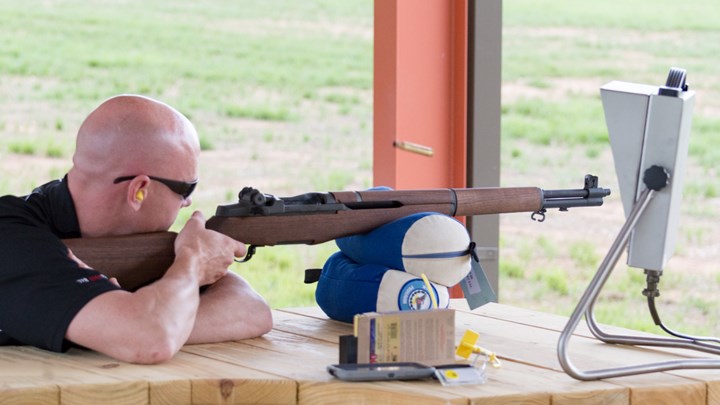
Revered by collectors, enthusiasts and competitors alike, the M1 Garand rifle has a certain mystique that makes it not only attractive to own, but also just plain fun to shoot. While a collector is going to spend time ensuring that every inch of the Parkerized steel and American walnut are in pristine condition, the enthusiast is probably more concerned that the rifle runs.

However, the competitive shooter cares most about how well Grandpa’s rifle can still lay ‘em into the X-ring. Sure, the gun has to run through 50 rounds without a hiccup, but that’s no tall task for the greatest battle implement ever devised.
As much as I love the old warhorse, if you are shooting one in a Service Rifle match, you are already at a disadvantage in the accuracy department, and need all the help you can get. If you are lucky enough to make it to Camp Perry for the John C. Garand Match, bring your A-game, as the firing line there is full of eager competitors who have been prepping for it all year.
I enjoy competing in fun shoots with my M1 Garand, and even occasionally play around with it for load development. Here is an outline of my practical maintenance routine that has shaved several MOA of error from my favorite piece of American heritage.
Cleaning
First, let’s address cleaning. The .30-06 Springfield round is moving fast enough to weld copper to your bore, and if you are shooting inexpensive surplus or steel-cased ammunition, expect an equal amount of carbon fouling. Begin with Hoppe’s foaming bore cleaner to get everything loosened up. Note that this cleaner comes with a warning NOT to use it with guns that have a gas system, but that’s actually why I’m drawn to it. In a firearm where the gas system is tough to access this could be a problem, however, in the M1 it’s quite easy to get out, and the foam cleans these parts in the process. As the foam expands, it flows through the gas port and if still attached, the gas cylinder. Most of the time, I fill the barrel with foam, and let it sit while I field strip. This gives it extra time to work, and simultaneously the foam works its way into the gas system and removes carbon fouling.

After about 30 minutes, wipe the gas cylinder with a rag and push the foam out of the bore with a spear-pointed jag and patch. Next, scrub the bore with a phosphor-bronze brush and Hoppe’s No. 9. Again, let this sit for 30 minutes before finishing the job with alternating wet and dry patches. After this, swab the bore with Sweet’s 7.62 Copper Solvent to get the final layer of copper out, and then immediately “rinse” with Hoppe’s No. 9 to ensure that every bit of the highly corrosive Sweet’s is removed. Finally, adding a light coat of CLP will help “grease the pan” and make the next cleaning session easy.
Sights
If a nice, clean bore is all that’s needed to shoot a 500, every match would be settled over X-ring hits. Getting an M1 Garand to shoot well, while still remaining “As-issued,” takes some work on the sights as well. Prior to disassembly, take note of any front sight wobble that the M1 Garand might be exhibiting. By using a punch and a hammer, you can gently peen (or smear) the metal that sits around the splines. This reduced the gaps slightly, and tightens up the overall fit of the gas cylinder to the barrel. Be careful, as it doesn’t take a lot to get a rock-solid lock up.

After tightening the front sight, take a cotton swab and clean out any dirt or dust that may have collected inside of the rear aperture. A clean peep sight is critical to accuracy; however, the absolute opposite is true for the front sight post. The darker and duller the front sight post is, the easier it is to pick up when building a sight picture. Try lighting a piece of masking tape on fire and using the smoke to coat the entire surface of the post. As the rubber-based adhesive burns, it leaves a jet-black film on any metallic parts that are over it. This also helps eliminate any reflection from the mid-day sun.

The maintenance routine is finished by greasing as instructed in the FM 23-5 field manual, and then adjusting zero (if necessary) after firing five fouling shots.
Generally, I don't bother giving too much attention to the stock. Issued USGI stocks with cartouches are becoming more collectible and should be left alone if in otherwise decent shape. Nothing is needed unless the wood begins to get raw and dry, in which case drying oils like raw linseed oil can be applied as instructed in FM 23-5. The metal doesn't need too much attention, though it doesn't hurt to have a protective layer of oil impregnated into the exposed metal surfaces, especially in more humid environments. It's also recommended to lightly coat certain areas with grease, like Lubriplate 130-A, where moving metal parts of the action make contact. These areas include the camming and guiding surfaces for the bolt, the operating rod receiver track, the bottom of the barrel where the operating rod touches and the bolt-camming lug on the hammer. With just a little bit of upkeep, John C. Garand's iconic rifle will work reliably and continue to last.
See more: Garand Entrance: The National Match Debut Of The M1 Rifle



































